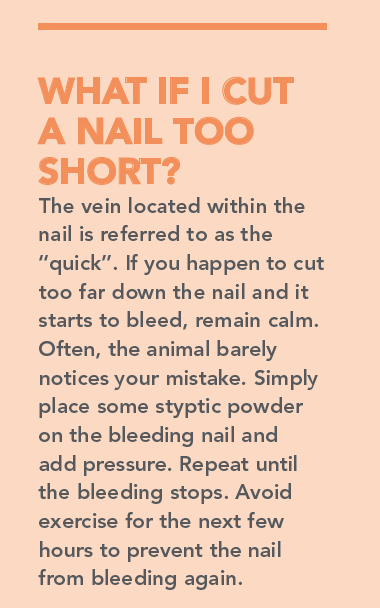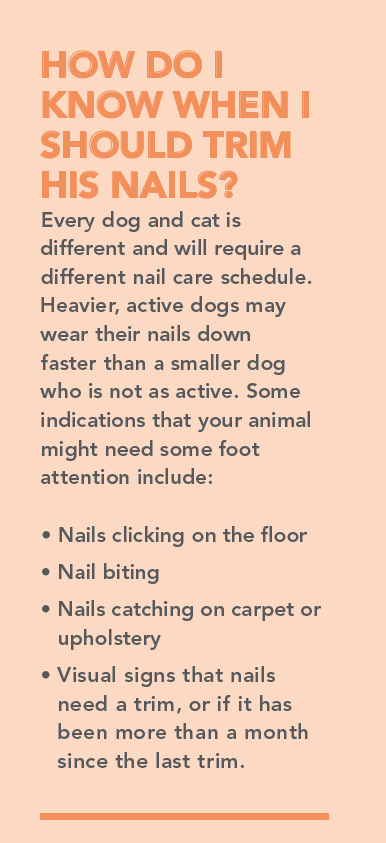Nail care for dogs and cats

Clipping your dog or cat’s nails isn’t just about protecting your furniture or floors. It’s also important for his health and comfort.
Most people cut their dog or cat’s nails because they want to prevent their hardwood floors from getting scratched, or their sofas from being shredded. But regular nail maintenance does a lot more than that. It also contributes to your animal’s comfort and well-being, in a multitude of ways.
Why should I clip my dog or cat’s nails?
Here are five good reasons for maintaining your animal’s nails at a healthy length.
1. Provides better traction
This is especially important for growing puppies, dogs with orthopedic problems, and elderly pets. Many of our canine and feline companions live indoors with us where floors can be slippery. Overgrown nails can force the animal’s foot up, allowing less of the pad to come in contact with the surface he’s walking or running on. This can lead to slips and injuries, not to mention scratches in your hardwood!
2. Reduces risk of injury
Animals with long claws can injure themselves while scratching. Long nails are also more likely to get caught in things, or to snap, causing pain that may require veterinary attention. Nails that are not properly maintained can cause injury to people and other animals as well

3. Prevents claws from growing into the pad
If left unattended long enough, nails can actually grow into the pad of the animal’s foot. This causes a great deal of pain and can lead to infection. Dewclaws (nails located on the upper side of the foot) are more likely to do this, but depending on your animal’s anatomy and exercise level, it can happen with any neglected nail.
4. Helps lessen orthopedic problems
Long nails can actually force an animal’s toes to spread, twist or lift when walking. This unnatural position can cause temporary discomfort or permanent structural issues, and even lead to arthritis. Keeping nails as short as possible will allow the animal to walk on the pads of his feet as intended.
5. Decreases damage to property
Of course, maintaining your dog or cat’s nails can prevent him from doing damage to furniture, flooring, doors, clothing, car interiors etc. Cats are particularly guilty of scratching inappropriately; you can prevent damage simply by keeping their nails trimmed and providing them with scratching posts.
What tools do I need for nail care?
Nail clippers
These generally come in two styles – scissor and guillotine. The scissor varieties are generally stronger, easier to maneuver, and come in a variety of sizes. Guillotine-style clippers allow you to insert the nail and cut on an angle. If possible, hold a few pairs in your hand before buying, and see which ones feel most comfortable.
 Nail grinder
Nail grinder
These are specialized dremel-like tools designed for pets’ nails. The motor spins a sand paper attachment while you hold the animal’s nail on it. The result is a smooth finish without sharp edges.
Nail file
A metal nail file is a good alternative to a motorized grinder tool — especially if you have a noise-sensitive dog or cat – and will smooth out any rough edges on the nail.
Styptic powder
Styptic powder can be applied to a nail that has been cut too short and is bleeding. It stops bleeding quickly. Styptic sticks can also be used.
How do I accustom my dog or cat to having his nails trimmed?
Most animals are sensitive about their feet being handled. If possible, it is best to start touching and handling a dog or cat’s feet and toes as early in life as possible. When the animal is in a calm state, begin to desensitize by simply touching his toes and feet. Massage and reward with treats or praise when he remains calm and receptive. Move on to tapping the nail with the clippers, and rewarding when this action is well received. After the nails have been clipped, follow up with a grinder or file to smooth edges. Make it a positive experience for you and your animal. Sometimes having a second person to comfort the dog or cat is all it takes to get the job done!
What if my animal is still stressed about nail clipping?
Dogs and cats can sense when a person is nervous, so make sure you approach the situation with confidence. Giving your animal a break between nails can help. Try to have him stand while you lift his feet, trimming like a blacksmith would a horse’s hooves — this can give you more control, allows you to see the quick easier from the underside, and can be a more comfortable position for your animal. (This might be easier with a dog than a cat!) Be careful not to manipulate his legs or force him through the process. Practice, patience and time will be required for your dog or cat to grow comfortable with nail maintenance.
When should I call a professional?
If your dog or cat gets aggressive or opposes trimming to the point of injuring himself, it might be best to leave his nail maintenance to the professionals. Consult your veterinarian or groomer if either you or your animal is uncomfortable with the nail trimming process. Regular nail trims with a professional are not usually expensive.



